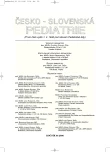Follow-up of Children with Unilateral Multicystic Dysplasia of Kidney
Authors:
H. Flögelová 1; O. Šmakal 2; P. Geier 1; K. Michálková 3; P. Koranda 4; R. Juřenčák 1
Authors‘ workplace:
Dětská klinika FN a LF UP, Olomouc
přednosta prof. MUDr. V. Mihál, CSc.
1; Urologická klinika FN a LF UP, Olomouc
přednosta doc. MUDr. F. Záťura
2; Radiologická klinika FN a LF UP, Olomouc
přednosta doc. MUDr. M. Heřman, PhD.
3; Klinika nukleární medicíny FN a LF UP, Olomouc
přednosta doc. MUDr. M. Mysliveček, PhD.
4
Published in:
Čes-slov Pediat 2006; 61 (3): 116-122.
Category:
Original Papers
Overview
Background:
The diagnostic and therapeutic approach toward multicystic dysplasia of kidney in children has changed significantly in recent years. Based on the analysis of a group of patients, this study aims to determine whether conservative treatment is safe.
Methods:
A retrospective chart review of 46 children (27 boys, 19 girls) with multicystic dysplasia of kidney admitted to our department between 1995 and 2003 was performed. The diagnosis of multicystic dysplasia of kidney was based on ultrasound findings. Renal nonfunction was confirmed in all children either by scintigraphy or intravenous urography. Blood pressure, ultrasound findings, occurrence of urinary tract infection and level of serum creatinine were followed up in all the patients.
Results:
Contralateral kidney anomalies were found in 20 children (43%): vesicoureteral reflux of grade I-IV in 13 children (28%), obstruction of pelviureteral junction in 3 children (6.5%) and primary obstructive megaureter in 4 children (8.5%). Nephrectomy for multicystic dysplasia of kidney was performed on 17 out of 26 children (65.4% of the children in this part of set) until 1999 and on 5 children out of 20 (25% of the children in this part of set) between the years 2000 and 2003. 22 children of the whole set (46 children) underwent nephrectomy, which equals to 47.8%. 33% of all conservatively treated patients had complete involution of multicystic kidney on ultrasound. Urinary tract infections only occurred in patients with vesicoureteral reflux (5 children, it is 10.9%). Hypertension was found in 3 children (6.5%). An increased level of serum creatinine was detected in 1 infant (2.2%) with contralateral hydronephrosis.
Conclusion:
Ultrasound examination is essential to diagnose multicystic dysplasia of kidney. Static scintigraphy will demonstrate nonfunction of a multicystic kidney and will assess the condition of contralateral kidney parenchyma. Due to a frequent occurrence of vesicoureteral reflux in the contralateral kidney, it is advised to perform voiding cystography. Long-term blood pressure monitoring is necessary in both conservatively and surgically treated patients. Conservative treatment is safe; nephrectomy should be considered individually depending on clinical signs and ultrasound findings (suspected malignant degeneration of multicystic dysplastic kidney or progressive cystic changes).
Key words:
cystography, multicystic dysplasia of kidney, nephrectomy, scintigraphy
Labels
Neonatology Paediatrics General practitioner for children and adolescentsArticle was published in
Czech-Slovak Pediatrics

2006 Issue 3
Most read in this issue
- X-linked Adrenoleukodystrophy in Twenty One Czech Patients
- Differential Diagnostics of Coagulation Disorders at the Child Age
- Alarm Treatment for Monosymptomatic Nocturnal Enuresis
- Follow-up of Children with Unilateral Multicystic Dysplasia of Kidney
